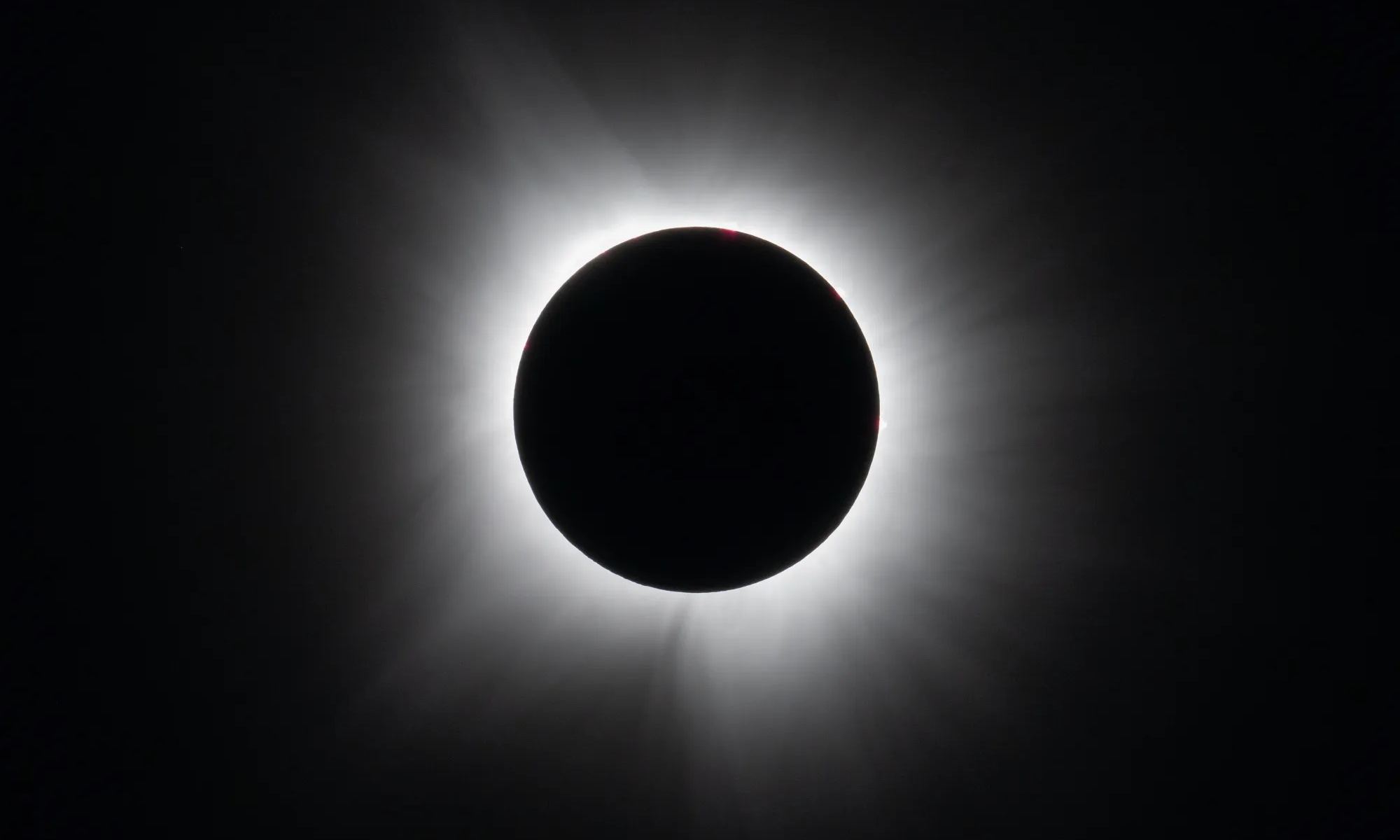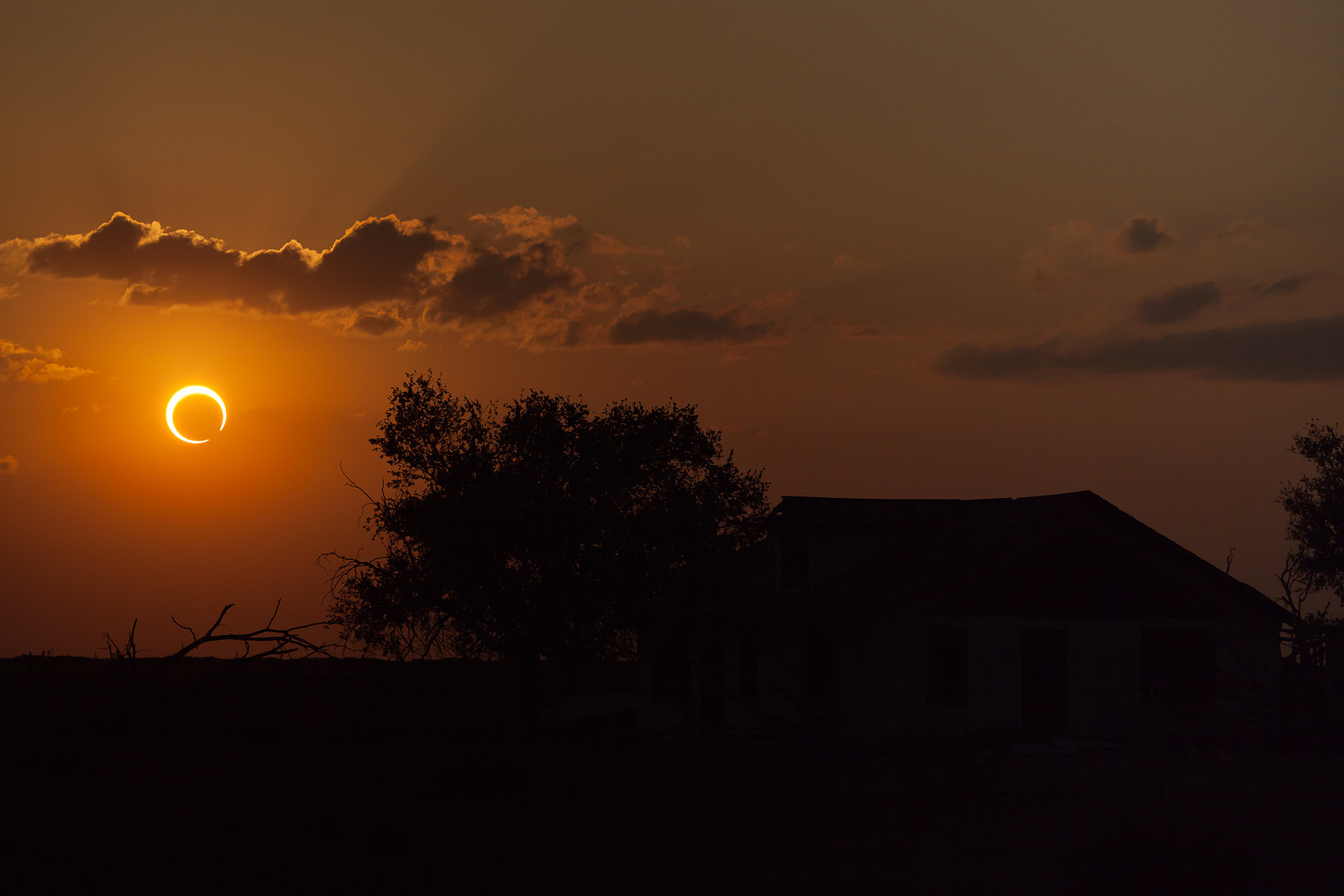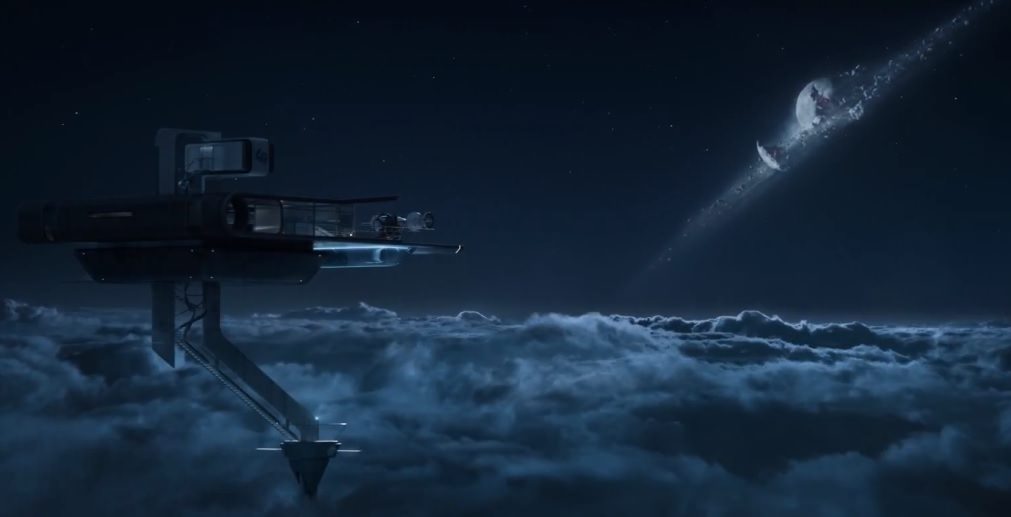Millions of people took a trip over to the US or Mexico to try and catch a glimpse of the 2024 total solar eclipse. Whether you took the trip or not, if you have since been bitten by the eclipse bug then there are three upcoming eclipses over the next couple of years. August 2026 sees an eclipse passing from Greenland, Iceland and Spain, 2027 sees an eclipse over North Africa and in 2028 Australia all be the place to be. With loads of possibilities for all locations, it’s time to get planning.
Continue reading “Here are the Next Three Total Solar Eclipses Coming Up”Want to Safely Watch the Sun With a Large Group? Get a Disco Ball

The upcoming solar eclipses and the current high sunspot activity means it’s a great time to observe the Sun. Eclipses also mean that large groups of people will be together to view these events. However, rule #1 for astronomy is to never look at the Sun with unprotected eyes, especially with a telescope or binoculars.
So, how can you safely show the changing Sun to a large group of people without having them line up forever to look through a telescope with a solar filter, or having a lot of equipment?
A group of astronomers have a solution: Get a disco ball.
Continue reading “Want to Safely Watch the Sun With a Large Group? Get a Disco Ball”Wow! Perseverance Sees a Solar Eclipse on Mars
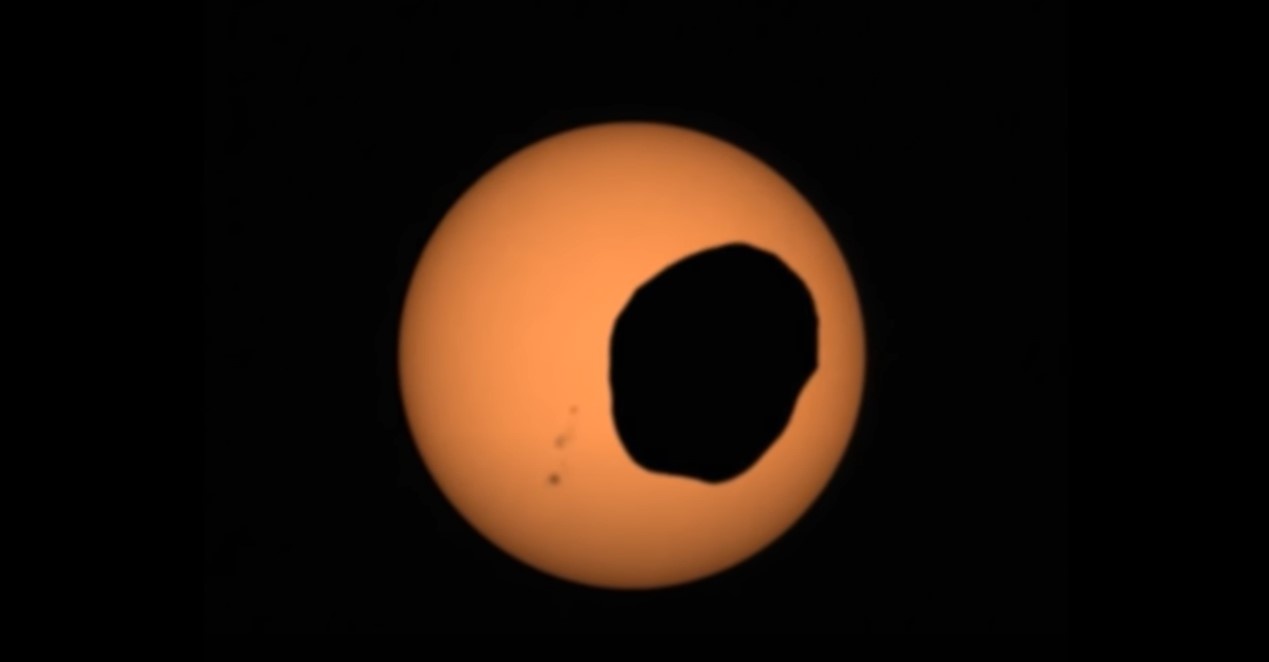
Imagine standing on Mars, and seeing this with your own eyes.
Continue reading “Wow! Perseverance Sees a Solar Eclipse on Mars”Mars Meets the MiniMoon During the Longest Total Lunar Eclipse of the Century
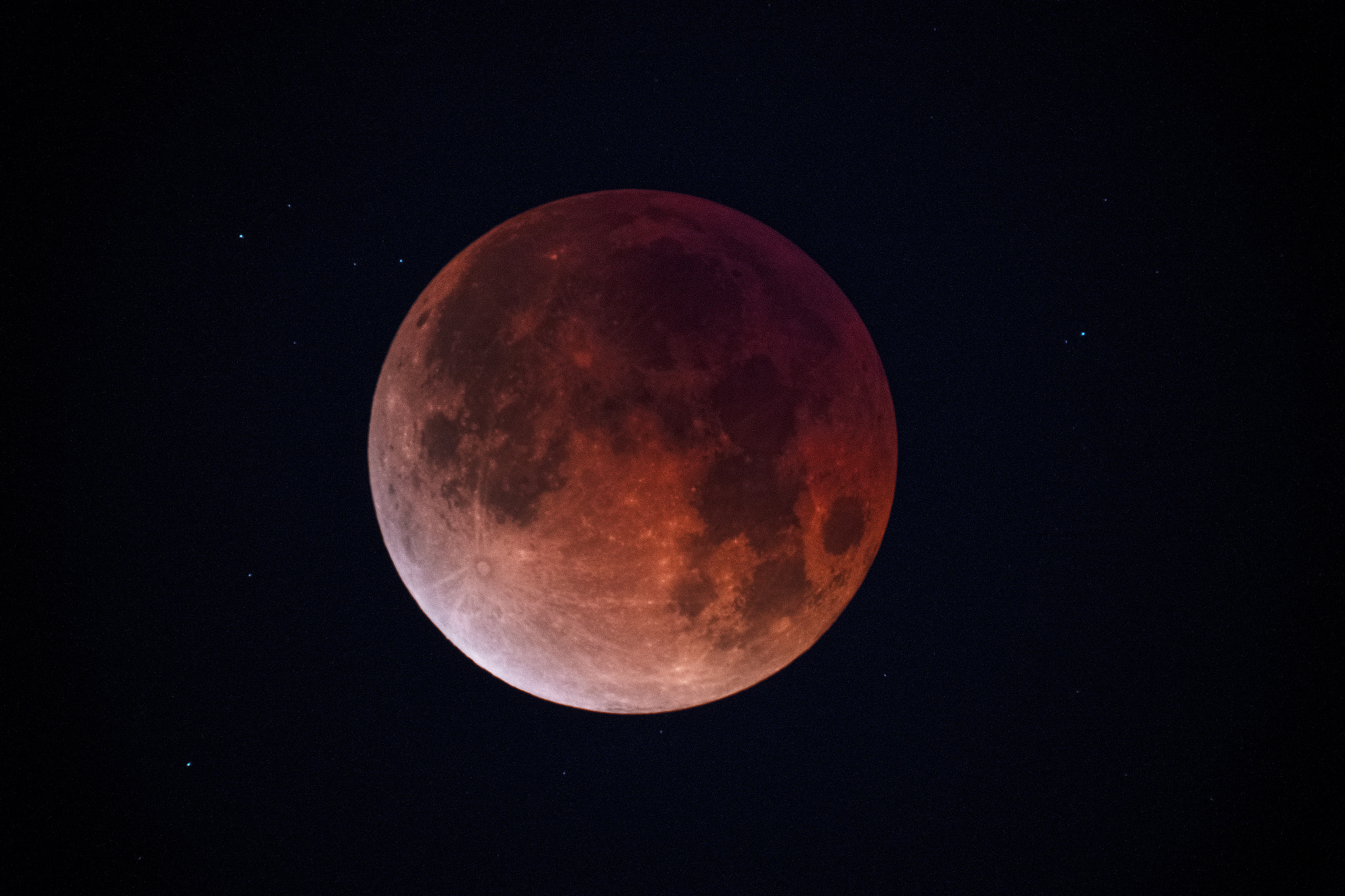
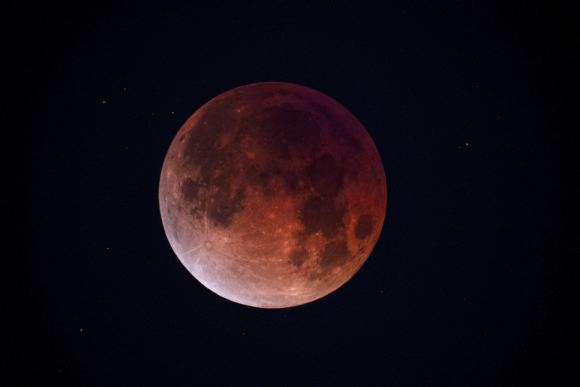
The Blood Moon cometh.
One of the top astronomy events of 2018 occurs on the evening of Friday, July 27th, when the Moon enters the shadow of the Earth for a total lunar eclipse. In the vernacular that is the modern internet, this is what’s becoming popularly known as a “Blood Moon,” a time when the Moon reddens due to the refracted sunlight from a thousand sunsets falling upon it. Standing on the surface of the Moon during a total lunar eclipse (which no human has yet to do) you would see a red “ring of fire” ’round the limb of the eclipsed Earth.
This is the second total lunar eclipse for 2018, and the middle of a unique eclipse season bracketed by two partial solar eclipses, one on July 13th, and another crossing the Arctic and Scandinavia on August 11th.
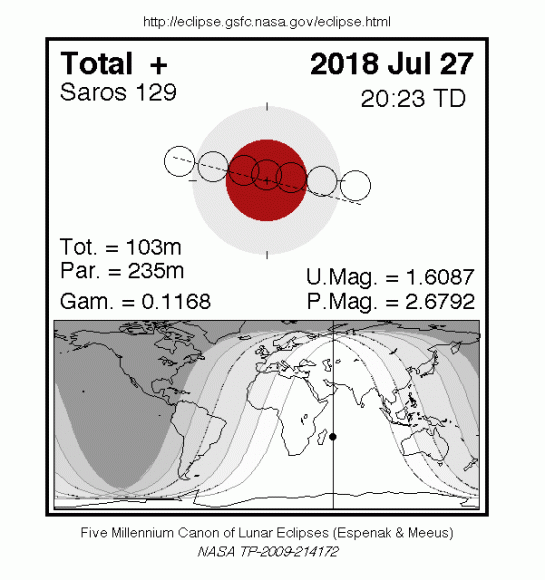
The July 27th total lunar eclipse technically begins around 17:15 Universal Time (UT), when the Moon enters the bright penumbral edge of the Earth’s shadow. Expect the see a slight shading on the southwest edge of the Moon’s limb about 30 minutes later. The real action begins around 18:24 UT, when the Moon starts to enter the dark inner umbra and the partial phases of the eclipse begin. Totality runs from 19:30 UT to 21:13 UT, and the cycle reverses through partial and penumbral phases, until the eclipse ends at 23:29 UT.
Centered over the Indian Ocean region, Africa, Europe and western Asia get a good front row seat to the entire total lunar eclipse. Australia and eastern Asia see the eclipse in progress at moonset, and South America sees the eclipse in progress at moonrise just after sunset. Only North America sits this one out.
Now, this total lunar eclipse is special for a few reasons.
First off, we’ll have the planet Mars at opposition less than 15 hours prior to the eclipse. This means the Red Planet will shine at a brilliant magnitude -2.8, just eight degrees from the crimson Moon during the eclipse, a true treat and an easy crop to get both in frame. We fully expect to see some great images of Mars at opposition along with the eclipsed Moon.
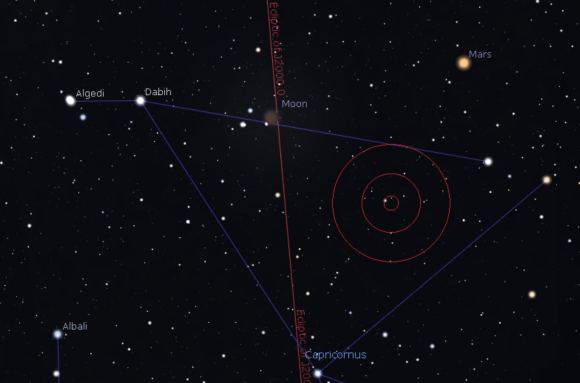
How close can the two get? Well, stick around until April 27th, 2078 and you can see the Moon occult (pass in front of) Mars during a penumbral lunar eclipse as seen from South America.
And speaking of occultations, the Moon occults some interesting stars during totality Friday, the brightest of which is the +5.9 magnitude double star Omicron Capricorni (SAO 163626) as seen from Madagascar and the southern tip of Africa. Omicron Capricorni has a wide separation of 22″.
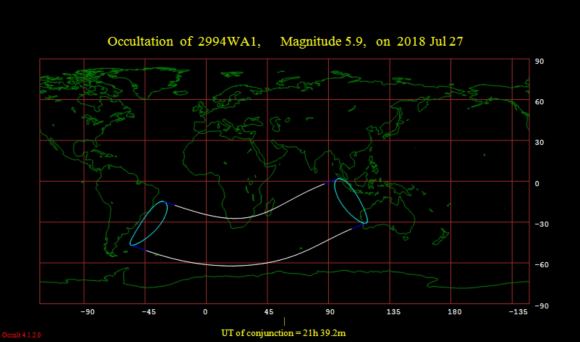
The second unique fact surrounding this eclipse is one you’ve most likely already heard: it is indeed the longest one for this century… barely. This occurs because the Moon reaches its descending node along the ecliptic on July 27th at 22:40 UT, just 21 minutes after leaving the umbral shadow of the Earth. This makes for a very central eclipse, nearly piercing the umbral shadow of the Earth right through its center.
Totality on Friday lasts for 1 hour, 42 minutes and 57 seconds. This was last beat on July 16th, 2000 with a duration of 1 hour, 46 minutes and 24 seconds (2001 is technically the first year of the 21st century). The duration for Friday’s eclipse won’t be topped until June 9th 2123 (1 hour 46 minutes six seconds), making it the longest for a 123 year span.
The longest total lunar eclipse over the span of 5,000 years from 2000 BC to 3000 AD was on May 31st, 318 AD at 106.6 minutes in duration.
A Minimoon Eclipse
Finally, a third factor is assisting this eclipse in its longevity is the onset of the MiniMoon: The Moon reaches apogee at July 27th, 5:22 UT, 14 hours and 37 minutes prior to Full and the central time of the eclipse. This is the most distant Full Moon of the year for 2018 (406,222 km at apogee) the 2nd most distant apogee for 2018. Apogee on January 15th, beats it out by only 237 kilometers. This not only gives the Moon a slightly smaller size visually at 29.3′, versus 34.1′ near perigee, less than half of the 76′ arcminute diameter of the Earth’s shadow. This also means that the Moon is moving slightly slower in its orbit, making a more stately pass through the Earth’s shadow.

What will the Moon look like during the eclipse? Not all total lunar eclipses are the same, but I’d expect a dark, brick red hue from such a deep eclipse. The color of the Moon during a eclipse is described as its Danjon number, ranging from a bright (4) to dark murky copper color (0) during totality.
Tales of the Saros
This particular eclipse is member 38 of the 71 lunar eclipses in saros series 129, running from June 10th, 1351 all the way out to the final eclipse in the series on July 24th, 2613 AD. If you caught the super-long July 16th, 2000 eclipse (the longest for the 20th century) then you saw the last one in the series, and the next one for the series occurs on August 7th, 2036. Collect all three, and you’ve completed a triple exeligmos series, a fine word in Scrabble to land on a triple word score.
Photographing the Moon
If you can shoot the Moon, you can shoot a total lunar eclipse, though a minimum focal length lens of around 200mm is needed to produce a Moon much larger that a dot. The key moment is the onset of totality, when you need to be ready to rapidly dial the exposure settings down from the 1/100th of a second range down to 1 second or longer. Be careful not to lose sight of the Moon in the viewfinder all together!
Are you watching the eclipse during moonrise or moonset? This is a great time to shoot the eclipsed Moon along with foreground objects… you can also make an interesting observation around this time, and nab the eclipsed Moon and the Sun above the local horizon at the same time in what’s termed a selenelion. This works mainly because the Earth’s shadow is larger than the apparent diameter of the Moon, allowing it to be cast slightly off to true center after sunrise or just before sunset. Gaining a bit of altitude and having a low, flat horizon helps, as the slight curve of the Earth also gives the Sun and Moon a tiny boost. For this eclipse, the U2-U3 umbral contact zone for a selenelion favors eastern Brazil, the UK and Scandinavia at moonrise, and eastern Australia, Japan and northeastern China at moonset.
Incidentally, a selenelion is the second visual proof you see during a lunar eclipse that the Earth is indeed round, the first being the curve of the planet’s shadow seen at all angles as it falls across the Moon.
Another interesting challenge would be to capture a transit of the International Space Station during the eclipse, either during the partial or total phases… to our knowledge, this has never been done during a lunar eclipse. This Friday, South America gets the best shots at a lunar eclipse transit of the ISS:
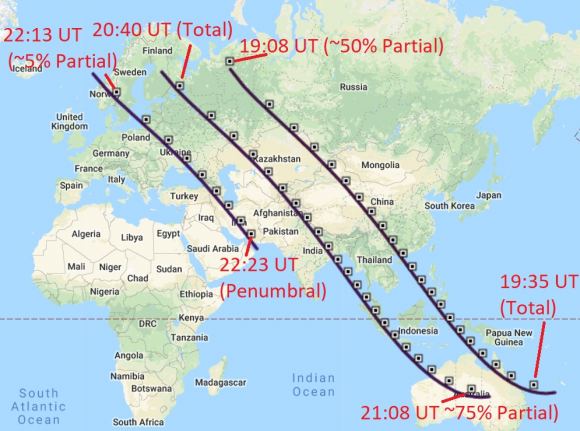
Be sure to check CalSky for a transit near you.
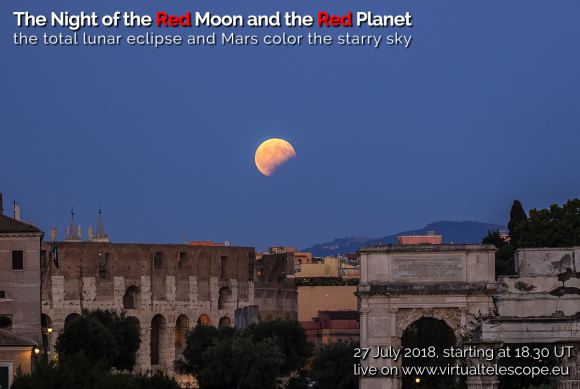
Live on the wrong continent, or simply have cloudy skies? Gianluca Masi and the Virtual Telescope Project 2.0 have you covered, with a live webcast of the eclipse from the heart of Rome, Italy on July 27th starting at 18:30 UT.
Be sure to catch Friday’s total lunar eclipse, either in person or online… we won’t have another one until January 21st, 2019.
Learn about eclipses, occultations, the motion of the Moon and more in our new book: Universe Today’s Guide to the Cosmos: Everything You Need to Know to Become an Amateur Astronomer now available for pre-order.
Ring of Fire: Catch the Only Annular Solar Eclipse of 2017 This Sunday
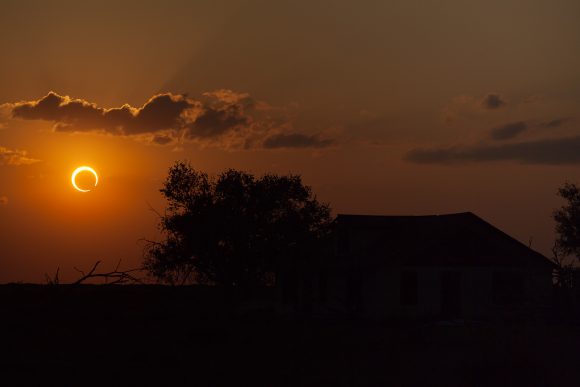
‘Tis the season… eclipse season that is, as a spectacular “ring of fire” annular solar eclipse marks the end of the first of two eclipse cycles for 2017. And although the annular path for this eclipse passes through some sparsely populated parts of the southern hemisphere, we just might get some amazing live views, courtesy of modern technology and some intrepid observers willing to adventurously trek after the shadow of the Moon.
Unlike many of the uncertainties in life, eclipses are sure to happen, a certainty ordained by orbital mechanics. Well, okay, the Vogons could always blow the Moon to smithereens this fine Thursday afternoon… but otherwise, we’re in for a true celestial show.
Eclipse circumstances: Prospects and prognostications.
The eclipse begins far out in the South Pacific at sunrise, and the path of annularity makes first landfall along the southern coast of Chile at 13:31 Universal Time (UT). The eclipse antumbra then races eastward over Argentina at 2.5 kilometers per second, as the “ring of fire” heads out over the South Atlantic where it reaches “maximum annularity” of just 44 seconds 900 kilometers southeast of Brazil. Finally, the 30 kilometer wide path touches down over Angola, nicks Zambia and ends at sunset over a southern track along the Democratic Republic of the Congo. The eclipse is partial across southern portion of South America, the Falkland Islands a swath of Antarctica and southwestern Africa.
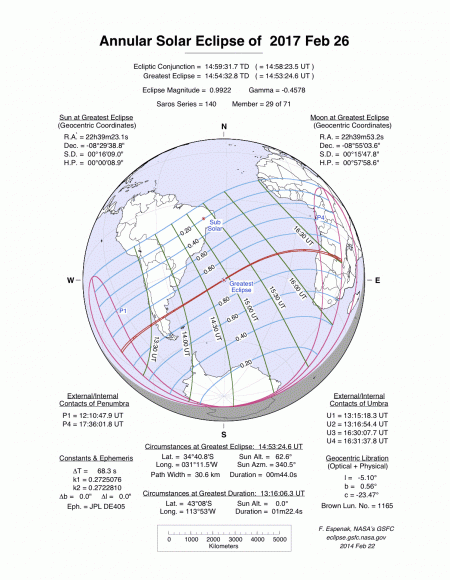
Here are the partial prospects for select cities:
City – Maximum obscuration – Time
La Paz, Bolivia – 5% – 13:37 UT
Buenos Aires – 67% – 13:53 UT
The Falkland Islands – 71% – 13:56 UT
Palmer Station, Antarctica – 31% – 14:01 UT
Cape Town, South Africa – 41% – 15:59 UT
Luanda, Angola – 83% – 16:32 UT
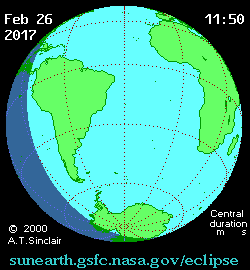
Annular vs. Total
Sunday’s eclipse is the first of two solar eclipses for 2017, and the only annular eclipse for the year. We get an annular eclipse when the Moon is near apogee (which occurred eight days ago on February 18th) and the Earth is near perihelion (which occurred last month on January 4th). At this time, the apparent size of the Moon is too small to cover the Sun as seen from the Earth, resulting instead in a brilliant annulus or “ring of fire” in the sky. Likewise, we refer to the shadow trace of this ring across the Earth as an antumbra, instead of the familiar umbra of a total solar eclipse.
Strange as it may seem, annular eclipses are slightly more common than total solar eclipses in our current epoch, and will become increasingly more so as the Moon slowly recedes from the Earth.

Observing and Eclipse Safety
Unlike a total solar eclipse, safety precautions must be taken during all phases of an annular solar eclipse. We witnessed the 1994 annular eclipse from the shores of Lake Erie, and can attest that 1% of the Sun is still pretty darn bright. Use only telescope and camera filters or glasses designed specifically for solar observing, even during the annular phase. Venus should also be a splendid sight for those observing near sunset from Africa, as the Cytherian world shines at -4.3 magnitude 34 degrees east of the Sun. Viewers in southwestern African nations will also be treated to a setting Sun during the eclipse, affording the chance to include the spectacle in shots along with foreground objects on the local horizon if skies are clear.
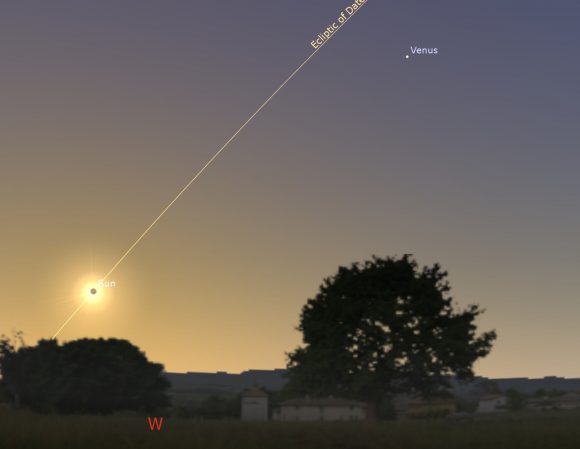
Clouded out? Live on the wrong part of the planet? There are actually several options to watch the eclipse live:
the venerable SLOOH plans to webcast the eclipse.
Time and Date will provide a webcast starting at 12:05 UT from Angola:
Watch this space: we’ll be dropping in more live webcasts of the eclipse as they turn up.
Update: VTR Chile may provide a live broadcast come eclipse time.
Plan on doing an ad hoc webcast of Sunday’s eclipse from anywhere along the annular or partial track? Let us know!
Sunspot activity is currently at a lull, and the Earthward face of Sol may well be blank come eclipse day. At an eclipse magnitude of 99.22%, this eclipse juuuusst misses being a hybrid/total. It’s also possible to catch the brief flashes of Bailey’s Beads along the edge of the antumbral graze line.
Tales of the Saros
This eclipse is member 29 of 71 for saros cycle 140, stretching all the way back to April 16th, 1512 and running out to June 1st, 2774. If you caught the February 16th, 1999 annular eclipse from the Australian Outback, then you witnessed the last eclipse in saros 140. Stick around until March 9th, 2035 and you can then complete an exeligmos or triple saros cycle, joining an elite club of eclipse-chasing adventurers, indeed.
Eclipses occur in pairs or sometimes triplets, when the nodes where the Moon’s orbit intersect the position of the Sun and the Earth’s shadow along the ecliptic plane. These nodes move due to orbital precession of the Moon’s path around the Earth. If the Moon weren’t inclined relative to the ecliptic, we’d see a lunar and solar eclipse every synodic month. The February 11th penumbral eclipse ushered in the current eclipse season, which ends with this weekend’s annular eclipse.
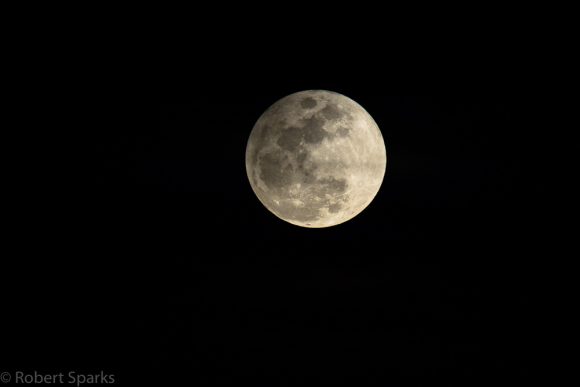
ISS and Views from Space (-ace -ace) Prospects
There is an ISS transit over SW Africa at around 15:45 UT, offering a chance to catch a transit of the station across the partially eclipsed Sun. Sun observing spacecraft in low Earth orbit including Hinode and Proba-2 also usually get good views of the eclipse.
New Moon sightings: And for the rest of the world, the hunt will be on to recover the slim waxing crescent Moon post-eclipse on the evening of Monday, February 27th. This lunation, first sighting opportunity without optical assistance favors southeast Asia.
Then, its on to eclipse season number two, featuring a partial lunar eclipse on August 7th, and then the big ticket event: the total eclipse of the Sun spanning the contiguous United States from coast to coast. Umbraphiles have been planning for this one and its brief 160 seconds maximum of totality for well over a decade now, no lie. Where will YOU be?
-Send those eclipse pics in to Universe Today Flickr.
-Read more about eclipses, occultations, comets and more for the year in our free e-book: 101 Astronomical Events for 2017.
-Eclipse science fiction? Read our original sci-fi tales Exeligmos, The Syzygy Gambit, Peak Season and more.
Citizen Scientists Help Crack 300 Year Old Mystery Of Eclipse Wind
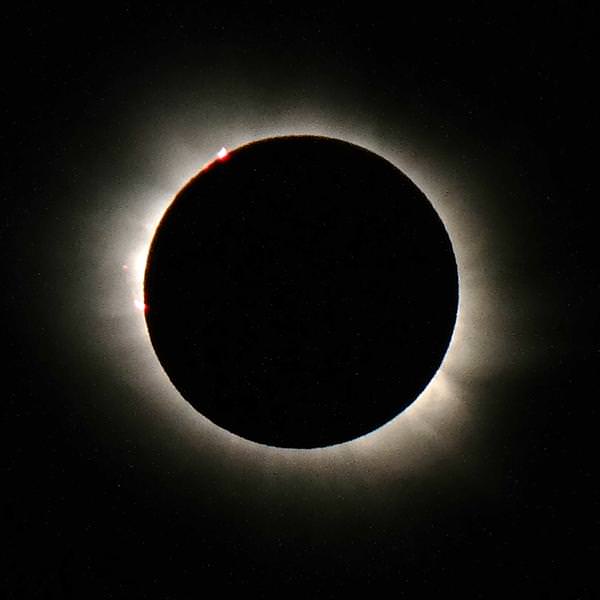
Being able to witness a solar eclipse is certainly a distinct experience. Even though the spectacle is mostly visual, there can be other effects as well. The air can cool, and observers may notice a decrease in wind speed or a change in wind direction. There might even be an eerie silence.
Experiences like this have been noted for centuries, and famed astronomer Edmund Halley wrote of the ‘Chill and Damp which attended the Darkness’ during an eclipse in 1715, which he noted caused ‘some sense of Horror’ among those who were witnessing the event.
While most people would describe an eclipse as ‘awe-inspiring’ (and not horrifying at all) the atmospheric changes noted by observers over the years has been called the “eclipse wind.” And now, based on the observations of over 4,500 citizen scientists in the UK during the partial eclipse on March 20, 2015, this effect is not just a figment of anyone’s imagination; it is a real phenomenon.
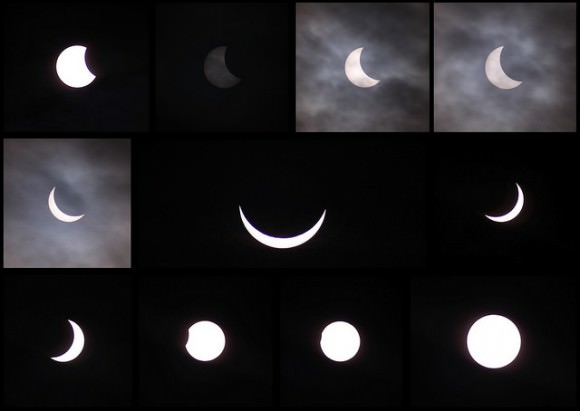
The National Eclipse Weather Experiment (NEWEx) was a UK-wide citizen science project for collecting atmospheric data during that eclipse. Members of the public – including about 200 schools – recorded weather changes such as air temperature, wind speed, wind direction and cloud cover every five minutes during the eclipse. That data, submitted online, was compared with official data from the UK’s Met office observations, the United Kingdom’s national weather service.
“The NEWEx was, as far as we know, a world first, in measuring and analyzing eclipse changes in the weather on a national scale, in close to real time, through engagement of a network of citizen scientists,” wrote researchers Luke Barnard, Giles Harrison, Suzanne Gray and Antonio Portas from the University of Reading, in one of a series of new papers about eclipse meteorology published this week.
The data revealed that not only did the atmosphere cool during the eclipse – which is not surprising since solar radiation is being blocked by the Moon – but the winds and cloud cover also decreased. The cumulative effect is real, not just anecdotal, the team said.
The Data
NEWEx collected 15,606 meteorological observations from 309 locations within the UK and from those observations the science team was able to derive estimates of the near-surface air temperature, cloudiness and near-surface wind speed fields across many UK sites. The data submitted by citizen scientists were combined with Met Office surface weather stations and a network of roadside weather sensors that monitor highway conditions. The combination of data helped unravel the centuries-old mystery of the eclipse wind.
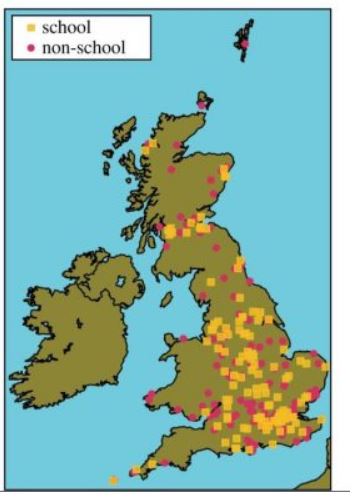
“There have been lots of theories about the eclipse wind over the years, but we think this is the most compelling explanation yet,” said Harrison in a press release from the University of Reading in the UK. “As the sun disappears behind the moon the ground suddenly cools, just like at sunset. This means warm air stops rising from the ground, causing a drop in wind speed and a shift in its direction, as the slowing of the air by the Earth’s surface changes.”
The measurements from citizen scientists clearly showed temperature drops and a decrease in clouds. The team did note that because of the low velocity of winds and some areas where cloud cover change was small, it was difficult for the participants to make some of the measurements. But the high level of participation across the UK provided enough data for the team to make their conclusions.
“Halley also relied on combining eclipse observations from amateur investigators across Britain. We have continued his approach,” Harrison said.
A total of 16 new papers and reports were published this week in a special ‘eclipse meteorology’ issue of the world’s oldest scientific journal, Philosophical Transactions of the Royal Society A. The special issue is published 301 years after Halley’s report of the eclipse in London in 1715 – and in exactly the same journal.
The team wrote that they hope a similar citizen science effort might take place in August 2017, when a total solar eclipse will be visible from North America, providing another opportunity to study eclipse-induced meteorology changes.
“NEWEx serves as a useful example of the strengths and challenges of using a citizen science approach to study eclipse-induced meteorological changes, and could provide a template for a similar study for the August 2017 eclipse,” the team said.
Sources: Paper: The National Eclipse Weather Experiment: an assessment of citizen scientist weather observations, Philosophical Transactions of the Royal Society A, University of Reading.
Weekly Space Hangout – Mar. 11, 2016: Dr. Sarah M. Milkovich
Host: Fraser Cain (@fcain)
Guests: Dr. Sarah M. Milkovich, Planetary Geologist and current Science Systems Engineer at JPL working on Mars 2020 Rover. She has also worked on MRO (HiRISE), MSL, Cassini (UVIS), and Mars Phoenix Mission.
Guests:
Morgan Rehnberg (MorganRehnberg.com / @MorganRehnberg)
Dave Dickinson (www.astroguyz.com / @astroguyz)
Paul Sutter (pmsutter.com / @PaulMattSutter)
Alessondra Springmann (@sondy)
Their stories this week:
InSight lives.. But at what cost?
Blue Origin targeting 2018 debut of space tourism
Amazing Views of This Weeks Eclipse
Drilling into Chicxulub crater
We’ve had an abundance of news stories for the past few months, and not enough time to get to them all. So we’ve started a new system. Instead of adding all of the stories to the spreadsheet each week, we are now using a tool called Trello to submit and vote on stories we would like to see covered each week, and then Fraser will be selecting the stories from there. Here is the link to the Trello WSH page (http://bit.ly/WSHVote), which you can see without logging in. If you’d like to vote, just create a login and help us decide what to cover!
We record the Weekly Space Hangout every Friday at 12:00 pm Pacific / 3:00 pm Eastern. You can watch us live on Google+, Universe Today, or the Universe Today YouTube page.
You can also join in the discussion between episodes over at our Weekly Space Hangout Crew group in G+!
Mind-Bending View of a Solar Eclipse from the Stratosphere
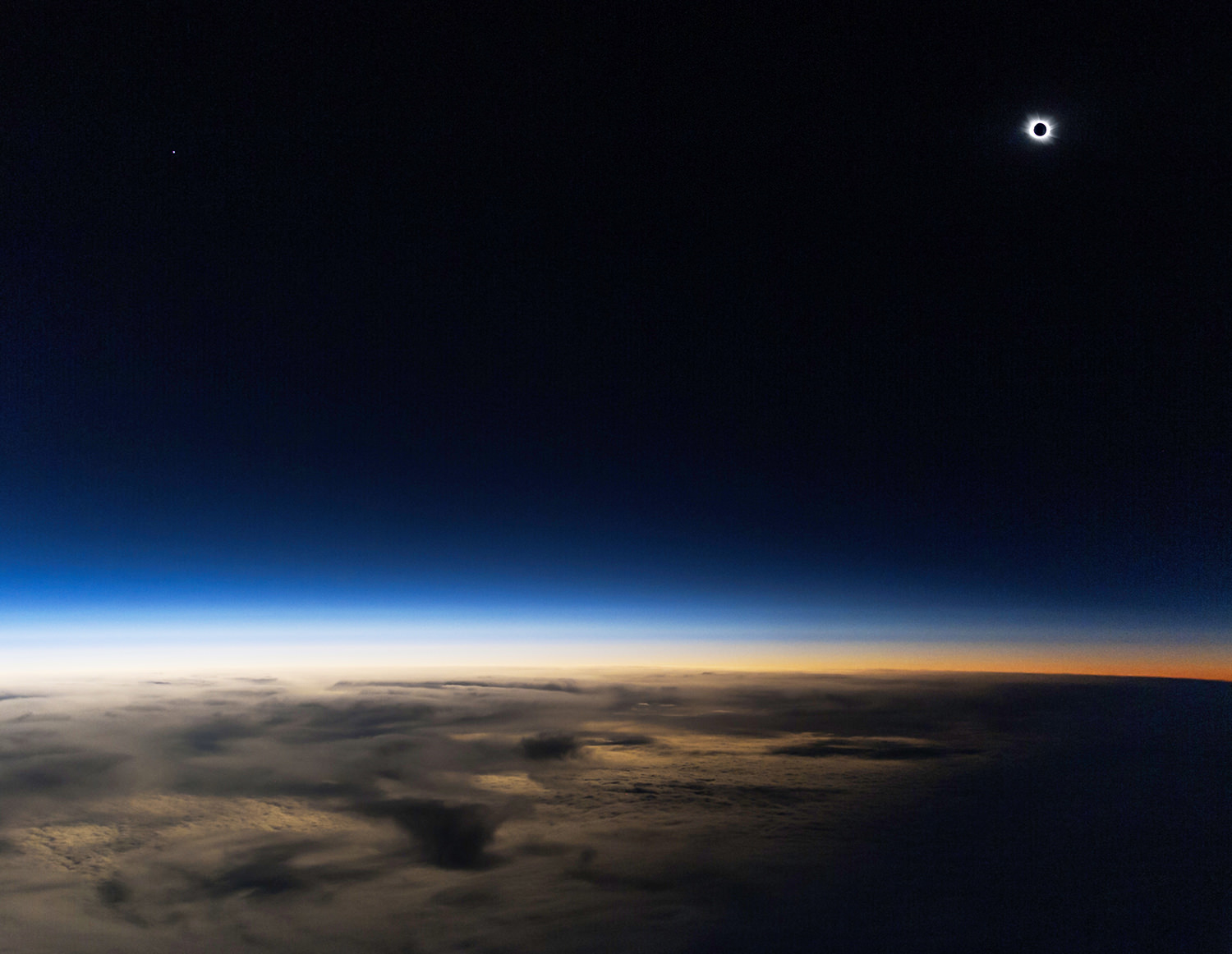
What does a solar eclipse look like from a fast-flying Falcon 7X jet at 14,000 meters (48,000 feet)? French journalist Guillaume Cannat described the Sun as looking black and “ruffled.”
Cannat was part of a group accompanying professional and amateur astronomers on board three Dassault Falcon 7X executive jets that flew in the narrow zone where totality of the eclipse could be observed, from southern Greenland to the geographic North Pole. Traveling through the stratosphere provided the unique opportunity to watch the total eclipse without atmospheric turbulence — which improved the view and the ride. And flying at speeds near Mach .9 also “lengthened” the view of the eclipse to over a minute.
Cannat described the view of totality:
“The crown was deployed around the black disc of the New Moon . It looks like a disheveled silver hair and matted by the solar wind. Far to the left, the planet Venus throws diamond chips, but the absorption of the window hides other celestial body that must always shine in the night daylight. Twilight slides around, bathing the distant clouds in a soft orange glow.”
Here’s a composite of several images of the eclipse that Cannat put together:
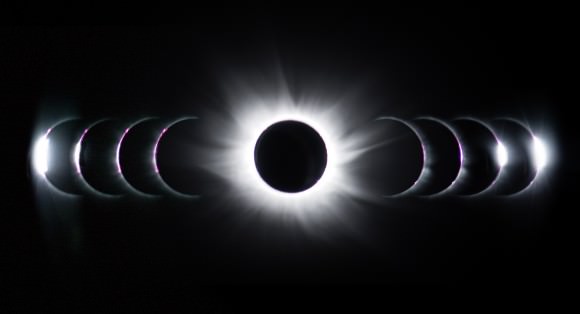
The flight was organized by French amateur astronomer Xavier Jubier who created the software Solar Eclipse Maestro. The jets were filled with observation equipment:
#Falcon7X's advanced pressurization system gives #eclipse2015 chasers the feeling they're barely over the tree tops.. pic.twitter.com/DmfL2HZK4M
— Dassault Falcon (@DassaultFalcon) March 20, 2015
Cannat also filmed the eclipse in real time with a GoPro Hero 4. “The whole sequence is rendered in real time so you can relive all in live conditions,” Cannat said. “Note, left, the presence of the bright spot of the planet Venus. The visible light rays around the sun before and after the totality phase are reflections on the window; there are also occasional reflections from inside the cabin. I left her to fully convey the mood of the scene. Naturally, I urge you to watch this video in HD 1080p to capture more detail and better see the spectacular growth of the shadow on cloud strata.”
And here’s a video of the adventure from Dassault Falcon:
Read Cannat’s full account (in French) and see more images at two posts at Le Monde here and here. Our thanks to Guillaume Cannat for sharing his images with Universe Today.
The Most Unique Eclipse Image You’ll Ever See

You’ve probably never before seen an image like the one above. That’s because it is the first time something like this has ever been created, and it is only possible thanks to two fairly recent NASA missions, the Solar Dynamics Observatory and the Lunar Reconnaissance Orbiter. We’ve shared previously how two or three times a year, SDO goes through “eclipse season” where it observes the Moon traveling across the Sun, blocking its view.
Now, Scott Wiessinger and Ernie Wright from Goddard Space Flight Center’s Scientific Visualization Studio used SDO and LRO data to create a model of the Moon that exactly matches SDO’s perspective of a lunar transit from October 7, 2010. They had to precisely match up data from the correct time and viewpoint for the two separate spacecraft, and the end result is this breathtaking image of the Sun and the Moon.
“The results look pretty neat,” Wiessinger said via email, “and it’s a great example of everything working: SDO image header data, which contains the spacecraft’s position; our information about lunar libration, elevation maps of the lunar surface, etc. It all lines up very nicely.”
‘Nicely’ is an understatement. How about “freaking awesome!”
And of course, they didn’t just stop there.
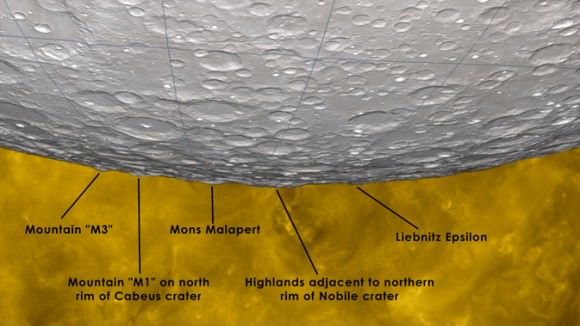
Since the data from both spacecraft are at such high resolution, if you zoom in to the LRO image, features of the Moon’s topography are visible, such as mountains and craters. This annotated image shows what all is visible on the Moon. And then there’s the wonderful and completely unique view in the background of SDO’s data of the Sun.
So while the imagery is awesome, this exercise also means that both missions are able to accurately provide images of what’s happening at any given moment in time.
Beautiful. See more imagery and info at this SVS page.
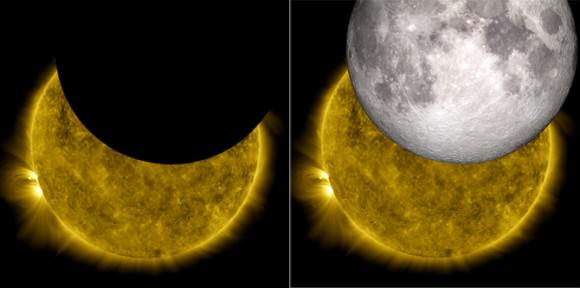
Into Oblivion: What If the Earth Had No Moon?
AVAST gentle reader: mild SPOILER(S) and graphic depictions of shattered satellites ahead!
We recently had a chance to catch Oblivion, the first summer blockbuster of the season. The flick delivers on the fast-paced Sci-Fi action as Tom Cruise saves the planet from an invasion of Tom Cruise clones.
But the movie does pose an interesting astronomical question: what if the Earth had no large moon? In the movie, aliens destroy the Earth’s moon, presumably to throw our planet into chaos. You’d think we’d already be outclassed by the very definition of a species that could accomplish such a feat, but there you go.
Would the elimination of the Moon throw our planet into immediate chaos as depicted in the film? What if we never had a large moon in the first place? And what has our nearest natural neighbor in space done for us lately, anyway?
Earth is unique among rocky or terrestrial planets in that it has a relatively large moon. The Moon ranks 5th in diameter to other solar system satellites. It is 27% the diameter of our planet, but only just a little over 1/80th in terms of mass.
Clearly, the Moon has played a role in the evolution of life on Earth, although how necessary it was isn’t entirely clear. Periodic flooding via tides would have provided an initial impetus to natural selection, driving life to colonize the land. Many creatures such as sea turtles take advantage of the Full Moon as a signal to nest and breed, although life is certainly resilient enough to find alternative methods.
The 2000 book Rare Earth by Peter Ward and Donald Brownlee cites the presence of a large moon as just one of the key ingredients necessary in the story of the evolution of life on Earth. A Moon-less Earth is also just one of the alternative astronomical scenarios cited by Arthur Upgreen in his 2005 book Many Skies.

Contrary to its depiction on film, the loss of the Moon wouldn’t throw the Earth into immediate chaos, though the long term changes could be catastrophic. For example, no study has ever conclusively linked the Moon to the effective prediction of terrestrial volcanism and earthquakes, though many have tried. (Yes, we know about the 2003 Taiwanese study, which found a VERY weak statistical signal).
All of that angular momentum in the Earth-Moon system would still have to go somewhere. Our Moon is slowly “braking” the rotation of the Earth to the tune of about 1 second roughly every 67,000 years. We also know via bouncing laser beams off of retro-reflectors left by Apollo astronauts that the Moon is receding from us by about 3.8 cm a year. The fragments of the Moon would still retain its angular momentum, even partially shattered state as depicted in the film.
The most familiar effect the Moon has on Earth is its influence on oceanic tides. With the loss of our Moon, the Sun would become the dominant factor in producing tides, albeit a much weaker one.
But the biggest role the Moon plays is in the stabilization of the Earth’s spin axis over long scale periods of time.
Milankovitch cycles play a long term role in fluctuations in climate on the Earth. This is the result of changes in the eccentricity, obliquity and precession of the Earth’s axis and orbit. For example, perihelion, or our closest point to the Sun, currently falls in January in the middle of the northern hemisphere winter in the current epoch. The tilt of the Earth’s axis is the biggest driver of the seasons, and this varies from 22.1° to 24.5° and back (this is known as the change in obliquity) over a span of 41,000 years. We’re currently at a value of 23.4° and decreasing.
But without a large moon to dampen the change in obliquity, much wider and unpredictable swings would occur. For example, the rotational axis of Mars has varied over a span of 13 to 40 degrees over the last 10 to 20 million years. This long-term stability is a prime benefit that we enjoy in having a large moon .
Perhaps some astronomers would even welcome an alien invasion fleet intent on destroying the Moon. Its light polluting influence makes most deep sky imagers pack it in and visit the family on the week surrounding the Full Moon.
But I have but two words in defense of saving our natural satellite: No eclipses.
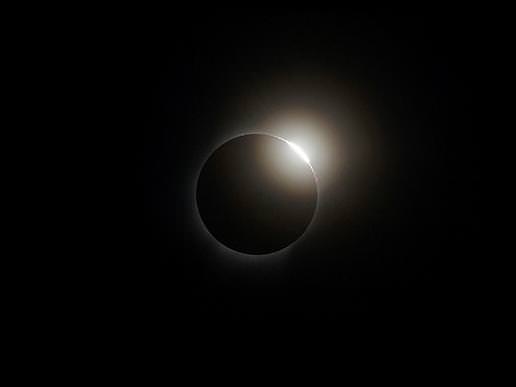
We currently occupy an envious position in time and space where total solar and lunar eclipses can occur. In fact, Earth is currently the only planet in our solar system from which you can see the Moon snugly fit in front of the Sun during a total lunar eclipse. It’s 1/400th the size of the Sun, which is also very close to 400 times as distant as the Moon. This situation is almost certainly a rarity in our galaxy; perhaps if alien invaders did show up, we could win ‘em over not by sending a nuclear-armed Tom Cruise after ‘em, but selling them on eclipse tours… Continue reading “Into Oblivion: What If the Earth Had No Moon?”

